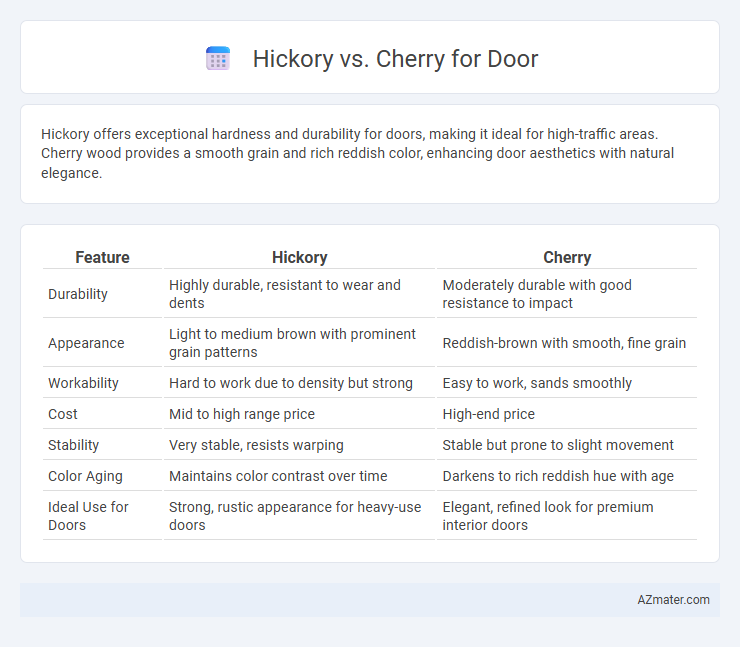Hickory offers exceptional hardness and durability for doors, making it ideal for high-traffic areas. Cherry wood provides a smooth grain and rich reddish color, enhancing door aesthetics with natural elegance.
Table of Comparison
| Feature | Hickory | Cherry |
|---|---|---|
| Durability | Highly durable, resistant to wear and dents | Moderately durable with good resistance to impact |
| Appearance | Light to medium brown with prominent grain patterns | Reddish-brown with smooth, fine grain |
| Workability | Hard to work due to density but strong | Easy to work, sands smoothly |
| Cost | Mid to high range price | High-end price |
| Stability | Very stable, resists warping | Stable but prone to slight movement |
| Color Aging | Maintains color contrast over time | Darkens to rich reddish hue with age |
| Ideal Use for Doors | Strong, rustic appearance for heavy-use doors | Elegant, refined look for premium interior doors |
Introduction to Hickory and Cherry Doors
Hickory doors are known for their exceptional hardness and distinct grain patterns, offering durability and a rustic aesthetic ideal for high-traffic areas. Cherry doors provide a smooth texture and rich, warm reddish-brown color that deepens over time, making them a popular choice for elegant and classic interior designs. Both wood types present unique features that influence their suitability for door applications in terms of strength, appearance, and aging characteristics.
Overview of Hickory Wood: Characteristics and Appearance
Hickory wood is renowned for its exceptional durability and strength, making it a popular choice for doors that require long-lasting performance. Its distinctive grain pattern features a mix of light and dark streaks, offering a rustic yet refined appearance that enhances door aesthetics. The wood's natural resistance to wear and impact adds functional value, ensuring that hickory doors maintain their structural integrity over time.
Cherry Wood: Features and Visual Appeal
Cherry wood offers rich, warm tones that deepen with age, providing doors with a timeless elegance and sophistication. Its fine grain and smooth texture create a sleek, polished surface ideal for high-end interior doors. Highly durable and resistant to warping, cherry wood combines both beauty and functionality, making it a preferred choice over hickory for luxurious door designs.
Durability and Strength: Hickory vs Cherry
Hickory offers superior durability and strength compared to cherry, making it an excellent choice for doors that require high resistance to wear and impact. Its dense grain structure provides enhanced hardness, resulting in better longevity and less susceptibility to dents or scratches. Cherry, while strong and resilient, tends to be softer and more prone to surface damage under heavy use, which may reduce its lifespan in high-traffic door applications.
Color Variation and Aging Process
Hickory doors exhibit strong color variation, ranging from pale cream to rich reddish-brown tones, with pronounced grain patterns that deepen and darken over time, enhancing their rustic appeal. Cherry doors start with a smooth, reddish hue that gradually ages to a rich, deep reddish-brown, developing a warm, lustrous patina through natural oxidation and exposure to light. The aging process of Hickory emphasizes contrast and rugged texture, while Cherry offers a more uniform, elegant darkening that highlights its fine grain structure.
Grain Patterns and Texture Comparison
Hickory doors feature pronounced, bold grain patterns with a rustic, textured appearance that emphasizes natural knots and color variation, ideal for creating a rugged or farmhouse aesthetic. Cherry doors exhibit a smoother texture with fine, straight grain patterns and a consistent, satiny finish that darkens over time, lending elegance and warmth to interior designs. The distinct grain complexity of hickory contrasts sharply with cherry's refined, uniform texture, making each wood type suitable for different design preferences and door styles.
Maintenance and Care Requirements
Hickory doors demand regular sealing and occasional sanding to prevent moisture damage and maintain their rustic appearance, while cherry doors require less frequent maintenance but benefit from periodic polishing to preserve their rich, reddish hue and smooth texture. Both woods are durable, but cherry's natural resistance to wear reduces the likelihood of surface scratches compared to hickory. Proper care for either wood includes avoiding excessive moisture, using mild cleaning agents, and applying protective finishes to extend the door's lifespan and aesthetic appeal.
Cost Differences: Hickory vs Cherry Doors
Hickory doors generally cost less than cherry doors due to the faster growth rate and greater availability of hickory wood, which reduces material expenses. Cherry doors command higher prices because cherry wood is prized for its rich color, fine grain, and increased demand, leading to limited supply and higher milling costs. When budgeting for interior or exterior doors, choosing hickory offers cost-effective durability, whereas cherry doors provide premium aesthetics with a corresponding price premium.
Best Applications for Each Wood Type
Hickory is ideal for doors requiring exceptional durability and rustic aesthetics, making it perfect for high-traffic entryways and farmhouse-style homes due to its hardness and distinctive grain patterns. Cherry wood offers a smooth texture and rich, warm tones that deepen with age, making it best suited for elegant interior doors and formal settings where visual appeal and fine finish are prioritized. Each wood's unique properties--Hickory's resilience and Cherry's luxurious look--define their optimal applications in residential and commercial door design.
Conclusion: Choosing the Right Wood for Your Door
Hickory offers exceptional durability and a bold, rustic grain pattern ideal for high-traffic doors requiring strength and unique character. Cherry provides a smooth, elegant finish with rich reddish tones that deepen over time, perfect for formal or traditional settings seeking warmth and sophistication. Selecting between Hickory and Cherry depends on whether durability and rustic appeal or refined aesthetics and color development align better with your door's functional and stylistic needs.

Infographic: Hickory vs Cherry for Door
 azmater.com
azmater.com